Zach Rolfe trial: Cop denies ‘making up’ testimony that Kumanjayi Walker went for his gun
Zach Rolfe has taken to the stand for the third day, denying he made up a testimony about Kumanjayi Walker. SEE THE LATEST VIDEO EVIDENCE
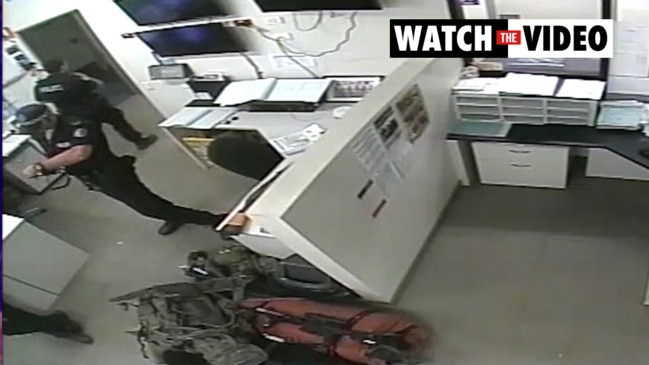
ZACH Rolfe has denied having “made up” his testimony that Kumanjayi Walker went for his gun during a life and death struggle in Yuendumu in 2019.
Rolfe took the stand in his Supreme Court murder trial for the third day on Friday after pleading not guilty to all charges stemming from the fatal shooting on November 9.
In cross examining him, Crown prosecutor, Philip Strickland SC, said it was “one of the most serious things that can happen to a police officer in a combat situation” but Rolfe said that was not the case on the day in question.
“Comparatively in this situation it was one of the least serious things that happened,” he said, noting his testimony that the officers were being attacked with an edged weapon at the time.
Rolfe agreed that he had been trained to shout “he’s going for my gun” if that ever happened but only “if practical”.
“You never even shouted the word gun, did you?” Mr Strickland asked.
“And you didn’t shout the word gun because Walker’s hand was never on your gun, was it?”
“Incorrect,” Rolfe replied.
“It would take more time for me to say ‘he’s grabbing my Glock’ than to move my hips backwards and knock his hand off my Glock.”
Rolfe admitted he had not told any of his fellow officers about Mr Walker trying to grab his gun and nor could it be seen on body worn camera footage of the incident.

Rolfe was also grilled about the words he is heard saying on the footage in the moments after firing the fatal shots.
“You said ‘It’s all good, he was stabbing me, he was stabbing you’ to justify what you had just done, didn’t you, because you knew you had gone too far?” Mr Strickland said.
“You knew you had been too gung ho, and you knew, didn’t you, that the shooting had been captured on your own body worn video, and you felt you needed to justify what you had just done?”
Rolfe replied “Incorrect”.
When asked why he had used the words “It’s all good”, he said he was “referring to the situation”.
“A violent offender had just been trying to murder two police officers and he no longer was,” he explained.
Mr Strickland also asked Rolfe about his earlier testimony that he had responded to then constable Adam Eberl’s question, “Did you ... ?”, to explain to him what had happened.
“You say you had the presence of mind to consider whether Eberl was suffering from symptoms of tunnel vision and auditory exclusion,” he said.
“You’re making that up too aren’t you?”
“No, I’m not,” Rolfe replied.
The trial continues on Tuesday when defence barrister, David Edwardson QC, told jurors he expects to call his final expert witness.
Zach Rolfe questioned on body-worn footage
ZACH Rolfe has denied becoming “obsessed” with body worn footage of an axe wielding Kumanjayi Walker running at police three days before he fatally shot him.
The NT Police officer took the stand in his Supreme Court murder trial for the third day on Friday, where Crown prosecutor, Philip Strickland SC, continued to question him about the footage.
Mr Strickland asked Rolfe if he had “become obsessed with drawing everyone’s attention to the body worn video”, which he denied.
“You hadn’t become preoccupied with the idea of you tracking down Kumnajayi Walker?” he asked.
“No,” Rolfe replied.
Rolfe also denied having a preformed plan to shoot Mr Walker before entering house 511 in Yuendumu on November 9, 2019.
“The clear plan in your mind was that if Kumanjayi Walker resisted you, you would shoot him, is that right?” Mr Strickland asked.
“If he presented an edged weapon to you, you would shoot him, that was your clear plan, wasn’t it?”
Rolfe said that was “incorrect”.
He has pleaded not guilty to all charges and the trial continues.
It comes as the media and general public are told not to travel to Yuendeumu as the trial unfolds.

Zach Rolfe applied to join elite TRG, SAS, court hears
ZACH Rolfe has been grilled about his aspirations to join NT Police’s elite Territory Response Group and the Australian Army’s special forces SAS unit under cross examination in his murder trial.
Rolfe took the stand in the Supreme Court for the second day on Thursday after pleading not guilty to all charges in relation to the fatal shooting.
Under questioning from Crown prosecutor Philip Strickland SC, the former soldier said his army experience, including a tour of Afghanistan, had made him “a better police officer”.
“I became a better learner,” he said.

“For example, when in the police force, learning to use an AR15 – a patrol rifle, I’d already had hands on that similar rifle before, I knew how to use it, stuff like that.”
Rolfe agreed with Mr Strickland that he had sought to rejoin the army via the elite Special Air Service in 2018 but denied it was “to become involved in more hands on situations”.
“Then I would’ve more likely joined the, tried to join, the commandos who are specifically into that role,” he said.
“The SAS was specifically a long range reconnaissance, specialist reconnaissance, unit and historically weren’t really involved in really direct action jobs like what you are talking about.”
Rolfe also denied having also applied to join the TRG “to become more involved in direct action jobs” but agreed he wanted “to be involved more in high-risk jobs”.
“I wanted to improve myself and improve my resume, that was part of it, so yes, I guess,” he said.
“Isn’t it the case that you obtained some excitement – some enjoyment – in being deployed to high-risk situations?” Mr Strickland asked.
“I wouldn’t call that excitement,” Rolfe replied.
Rolfe also told jurors the two shots he fired in “quick succession” after shooting Mr Walker the first time were not a “double tap”.
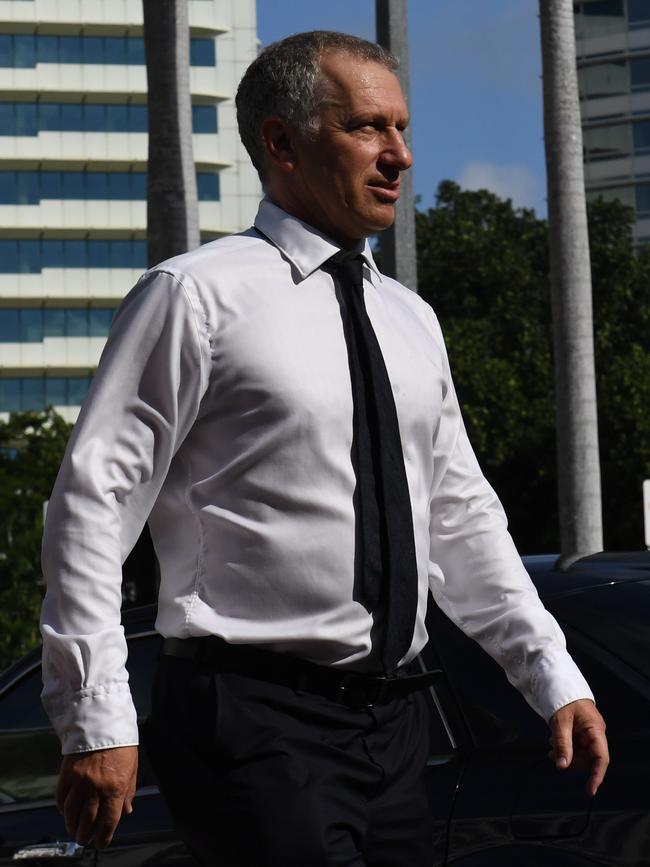
Mr Strickland asked if the two shots fired “one after the other”, with a gap of 0.53 seconds between the two, according to the agreed facts in the case, qualified as a “double tap” but Rolfe said it did not.
“Generally, (a double tap) would mean you take one sight picture and you fire as quick as possible, meaning that the shots would actually be, on average, about point two of a second apart,” he said.
Rolfe also disputed Mr Strickland’s suggestion that the shots were fired “at point blank range”, while accepting it was “extremely close”.
“My understanding of point-blank is nearly touching – is actually touching the target,” he said.
“It was very close, but that’s not touching.”
The trial continues on Friday.
Walker ‘reached for my Glock’, Rolfe tells court
KUMANJAYI Walker reached for Zach Rolfe’s Glock in the moments before the NT Police officer drew the weapon and fired the shots that killed him, a court has heard.
In giving evidence in his murder trial for the second day on Thursday, Rolfe watched on as body worn camera footage of Mr Walker’s final moments was played to the Supreme Court.
Rolfe told the court he “didn’t perceive a threat” when he and fellow officer Adam Eberl entered house 511 in Yuendumu on November 9, 2019 and confronted the 19-year-old, who gave his name as Vernon Dixon.
Rolfe said he identified Mr Walker by comparing him to a photo on his phone and satisfied himself he was the same man who had rushed at police with an axe three days earlier, before instructing him to put his hands behind his back.
“As soon as I said that, Kumanjayi started resisting, he raised his arms and started striking me around my head and neck area,” he said.
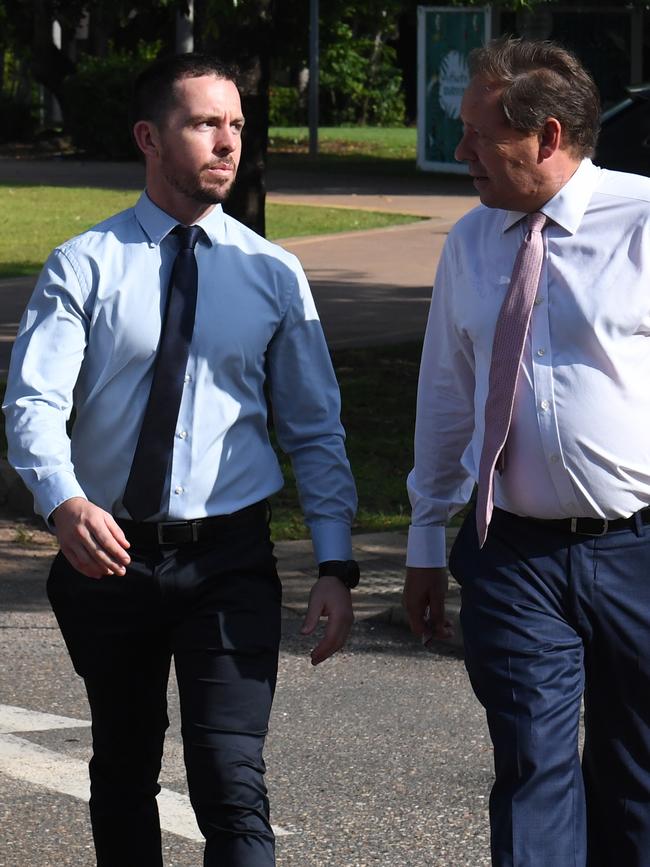
Rolfe said Mr Walker struck him twice “on top of the head in a hammer fist motion”.
“I thought this was strange because he wasn’t using his knuckles so at that point I looked at his hand and that was the first time I ID'd that he had a metal blade,” he said.
“Instinctively, at that time, I put my hand on my Glock, at which point I realised that his left hand was already on my Glock.”
Rolfe said he had immediately feared for his life upon seeing the blade, that he later learned was a pair of scissors, as well as for his partner’s life when he saw Mr Walker “stabbing Eberl in the chest and neck area”.
At this point, Rolfe said he believed Mr Walker was “potentially armed with a lethal weapon”.
“I drew my Glock and when it was safe to fire, still fearing for Eberl’s life, I fired one round into the centre of seen mass of Kumanjayi,” he said.
“I pulled the trigger and was able to confirm that I had hit the target.”
But Rolfe said Mr Walker was still “not at all” incapacitated as he and then Constable Eberl “continued to fight” on the ground, while Mr Walker’s right arm was “still moving and stabbing Const Eberl”.
“I moved towards the two and I placed my left hand on Eberl’s back, I did that because they were still fighting and still moving, I didn’t want him to be thrown, or move, back into my line of fire,” he said.
“I fired two more rounds into Kumanjayi’s centre of mass, at which point I observed his right arm stopped trying to stab my partner.”
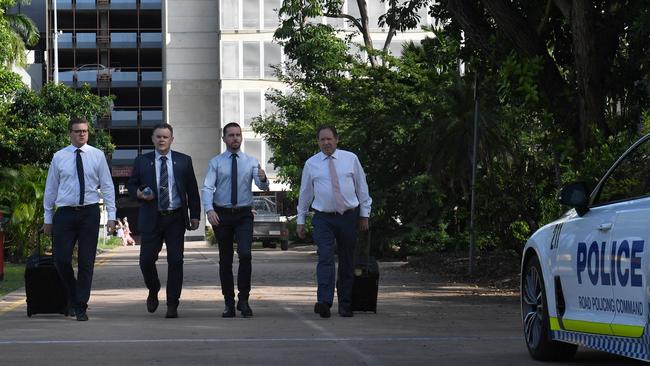
Under questioning from his barrister, David Edwardson QC, Rolfe said it was not practical or possible to use less than lethal force, and he had continued to fire in line with his training.
“I believed there was still an immediate threat to Eberl’s life and my training states that I should not go hands on with someone with an edged weapon unless I could not use my firearm,” he said.
Rolfe said he then reholstered his Glock and moved to assist Const Eberl in handcuffing Mr Walker but said he was still “definitely not” incapacitated even by this point.
“I believed he was still a threat and still held a lethal weapon, I just believed I could handle that situation moving forward with lesser force than using my firearm,” he said.
Rolfe has pleaded not guilty to all charges and the trial continues on Friday when Mr Strickland will resume his cross examination.
New footage released as Zach Rolfe takes the stand
ZACH Rolfe has taken the stand in his trial for the alleged murder of Kumanjayi Walker, telling jurors he was trained by NT Police to respond to the threat of an edged weapon by drawing his gun and being “prepared to pull the trigger”.
Rolfe has pleaded not guilty to all charges and took the stand in the Supreme Court on Wednesday after Crown prosecutor, Philip Strickland SC, closed the case against him over the fatal shooting in Yuendumu in 2019.
His barrister, David Edwardson QC, asked the formerly Alice Springs based constable what he learned the term “knife equals gun” meant in the course of his police training.
“The way I was trained was, if we were presented, if someone is threatening us with an edged weapon, our first response was to go for our firearm unless that was impossible,” he said.
“You only draw your firearm if you’re prepared to pull the trigger.”
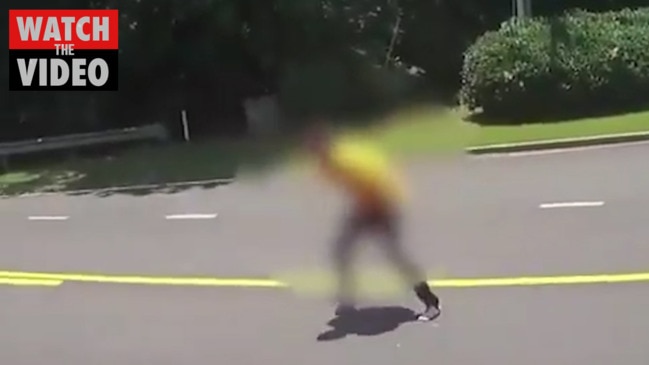
Rolfe said in a situation where an alleged offender presented an edged weapon, he was trained to draw his Glock to provide “lethal cover” and then “go from there”.
“If you had distance, you pull your weapon and you had lethal cover, you then had time to assess to see if there’s a difference, if the offender reacts differently, if you don’t have the distance or time then you don’t have the ability to cause that change,” he said.
“If the offender’s on top of you, you can’t assess the situation, or, you can assess the situation but you can’t so much utilise that distance.
“You aren’t always given the benefit of the distance in that situation.”
Rolfe said he was also trained in the use of a “shove and shoot” technique in response to an attack by a person armed with an edged weapon.
“They would attempt to strike us, we were drilled to defend ourselves with our non-dominant arm, with our dominant arm, draw our Glock and simulate firing rounds into the centre of mass of the assailant,” he said.
“The training was always you shoot until the threat is incapacitated no matter how many rounds that takes.”
Rolfe told the court he had watched body-worn camera footage of an incident from three days before the shooting in which Kumanjayi Walker threatened police with an axe, saying he felt it was “being swept under the rug”.
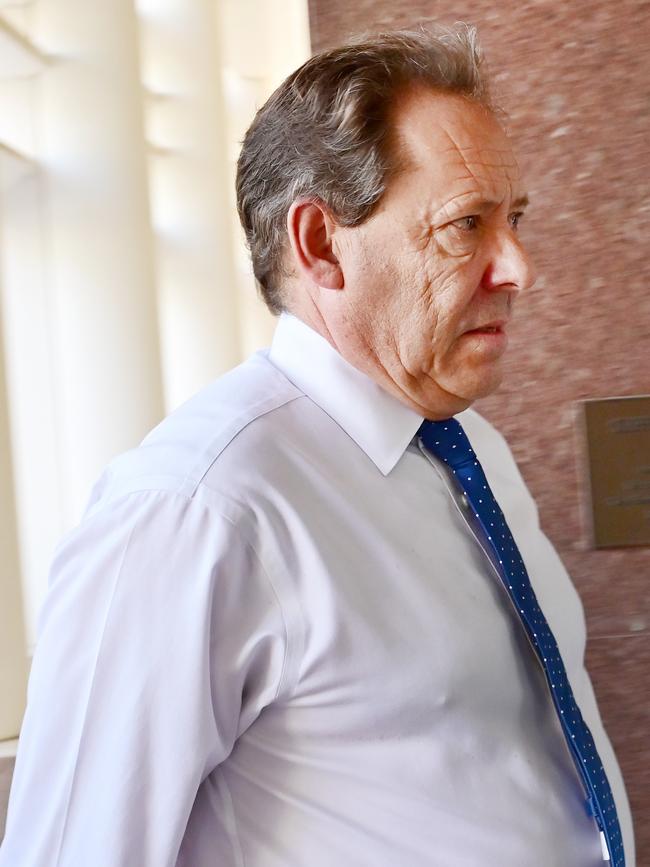
“It seemed that this was the kind of incident that we should all be alerted to,” he said.
“It’s known that people from Yuendumu and Alice Springs generally go between fairly often so this offender was potentially a risk to Alice Springs (police) members.
“I asked (shift sergeant Evan Kelly) to come watch the videos and we had a discussion about it and he agreed that the incident should have been relayed up the chain of command and a higher response should already have been organised.”
Rolfe said he had looked up Mr Walker’s history on the police record system and discovered he had “a very extensive criminal history” including “violence against women and violence against police”.
“I characterised him as a high risk offender, extremely violent, who was willing to use potentially lethal weapons against police,” he said.
Rolfe said he was later called up for an Immediate Response Team call-out on the day of the shooting by officer in charge, Shane McCormack, “to travel to Yuendumu to arrest (Kumanjayi) Walker”.
“I asked him specifically what our mission was, I asked him twice, and he confirmed it was to arrest Kumanjayi Walker,” he said.
Rolfe said he then drove to Yuendumu with Constable James Kirstenfeldt, arriving about 7pm, saying he could recall the pair having a conversation “about the mission”.
“We were obviously aware that the mission was to arrest Walker,” he said.
“The only comment that I can recall myself making is that we should have been sent out earlier, as in days earlier, not hours earlier.”
The trial continues on Thursday when Rolfe will continue his evidence before he is cross examined by Crown prosecutor Philip Strickland SC.
KUMANJAYI WALKER ‘NOT FULLY’ INCAPACITATED AFTER FATAL SHOTS
KUMANJAYI Walker was “not fully” incapacitated even after Zach Rolfe shot him three times in a life-and-death struggle with police in Yuendumu in 2019, a court has heard.
Rolfe has pleaded not guilty to all charges in relation to the fatal shooting, with prosecutors due to wrap up their case against him in the Supreme Court this week.
Under cross examination by defence barrister, David Edwardson QC, on Wednesday, Professional Standards Command Senior Sergeant, Andrew Barram, agreed Mr Walker never stopped resisting during the attempted arrest.
“At no stage till the handcuffs were finally placed on his wrists was Kumanjayi Walker ever compliant,” Mr Edwardson said.
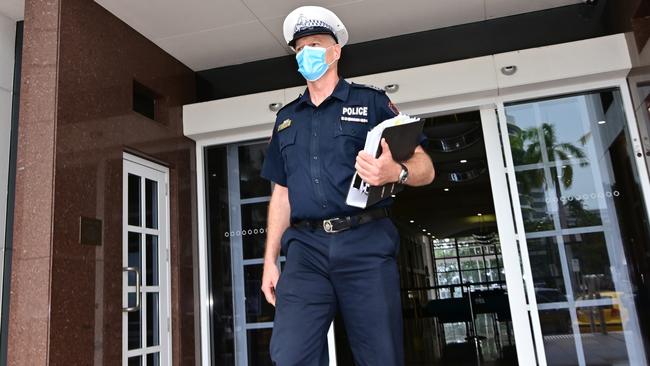
“He consistently continued to resist after the first shot and after the second and third.
“All you can say, at best, is to try and interpret what you can see on the (body worn) video, without knowing what was going through Zach Rolfe’s mind, what he could see and what he was thinking?”
Sr Sgt Barram replied: “Yes.”
The trial continues with the final Crown witness expected to be called on Wednesday.
Rolfe trial shown shocking footage of police shooting in United States
JURORS in Zach Rolfe’s murder trial have been shown shocking footage of a separate police shooting in the United States, in which an armed man is fired upon multiple times before continuing to threaten the arresting officers.
Under cross examination by Rolfe’s barrister, David Edwardson QC on Tuesday, Senior Sergeant Andrew Barram agreed he had shared the video on Facebook about a month before Rolfe shot and killed Yuendumu teenager Kumanjayi Walker during an attempted arrest in 2019.
The footage, recorded in Athens Clarke County, shows the man walking towards police as they shout at him to drop the weapon before he sets off at a running pace, still armed.
One of the officers then shoots the man repeatedly and he falls to the ground but then proceeds to regain his feet, approaching a second officer as the first draws his taser.
The man is seen grabbing the second officer around the neck before the first officer returns to his pistol and shoots him again, after which he finally stops moving.
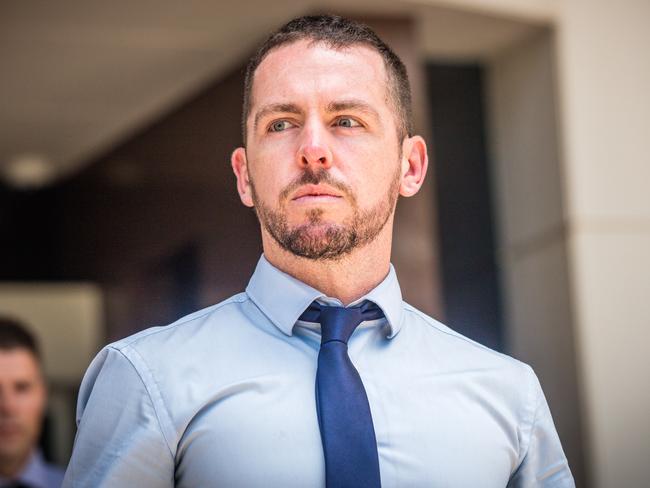
Sgt Barram agreed he had shared the video with the heading “brings a little bit of reality into the argument” and that the post included the words “why officers shoot until threat has stopped”.
Sgt Barram said while he also agreed the footage showed an “entirely different” scenario to the one at the centre of the current trial, it depicted the man being shot multiple times before continuing to present a threat to the officers.
He agreed with Mr Edwardson that it represented a “good indication” of why officers try to keep their distance from potential offenders and give verbal commands.
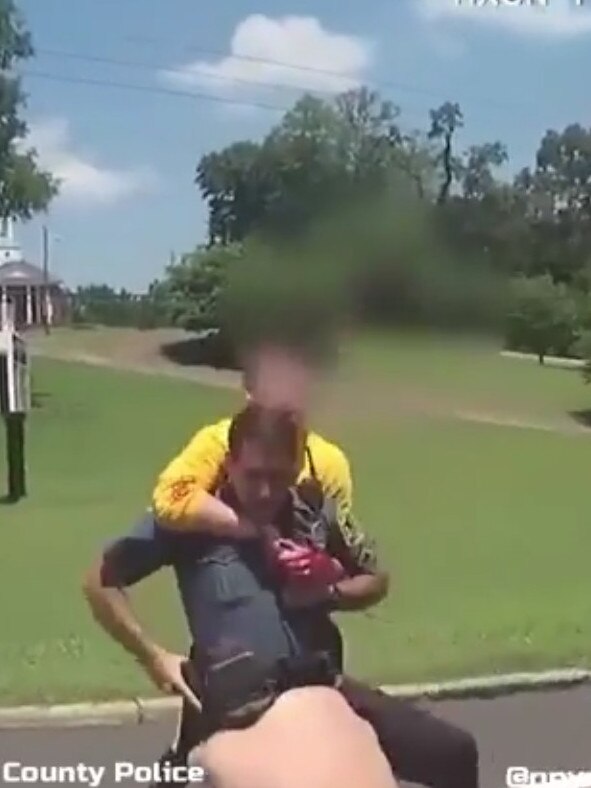
“In that case, the police officer had distance, time and a visual perspective on his or her side, that is not the scenario that confronted Zachary Rolfe at all?” he asked.
“Because what we do know is that weapon, the potentially lethal weapon, namely the scissors, were presented in a split second after he had asked Kumanjayi Walker to put his hands behind his back?”
“Yes,” Sgt Barram replied.
Rolfe has pleaded not guilty to all charges and the trial continues on Wednesday.
Zach Rolfe ‘justified’ in drawing Glock on Kumanjayi Walker, NT Police expert tells court
ZACH Rolfe was “justified” in firing his weapon at Kumanjayi Walker while trying to arrest him, but not in firing the second or third shots that killed him, an NT Police Professional Standards Command expert witness has told the Supreme Court.
Rolfe has pleaded not guilty to murdering the 19-year-old in Yuendumu in 2019, along with two other alternative charges, with his trial in Darwin now in its fourth week.
On Tuesday, Senior Sergeant Andrew Barram told the court he had reviewed the body worn camera footage of the shooting and concluded Rolfe was acting reasonably in firing the first time, while Mr Walker wrestled with his partner, then constable Adam Eberl.
“He was confronted at close range with an edged weapon, was actually stabbed with it in his shoulder, and it would have been reasonable to believe that his partner was also, at that point, in danger,” he said.
But Sgt Barram said even though the use of potentially deadly force was justified at that time, Rolfe still should have yelled “knife, knife, knife” to alert others nearby to the threat.

“To let your partner know, in case they haven’t seen it and let other police in the vicinity know and let members of the public know,” he said.
By the time Rolfe fired the second and third shots, Sgt Barram said “things had changed substantially”, with then Constable Eberl now grappling with Mr Walker on a mattress on the ground.
“They’d gone from a standing position, in a fairly equal fight, to being on the ground with Constable Eberl on top and pinning Mr Walker down,” he said.
Sgt Barram said he didn’t believe the firing of the second and third shots “tactically gave (the officers) any advantage” in effecting the arrest.
“As far as the fight was concerned, or the arrest of Mr Walker, the firing of those two shots made no difference to the tactical situation,” he said.
He said at that point, Rolfe should have used defensive “empty hand tactics”, rather than continuing to fire his Glock.
“Moving in and taking control, or helping take control, of Mr Walker on the ground,” he said.
The trial continues.
NT constable should not have entered property where teen was shot
ZACH Rolfe should never have gone into the house in which he shot and killed Kumanjayi Walker, an expert on NT Police training and tactics has told his murder trial.
Rolfe has pleaded not guilty in the Supreme Court to all charges in relation to the fatal shooting in Yuendumu in November 2019.
On Monday, Senior Sergeant Andrew Barram told jurors the actions of Rolfe and his arrest partner, then constable Adam Eberl, in entering the house “completely goes against our training”.
“They shouldn’t have gone in,” he said.
“If they suspected that it’s Mr Walker, and he’s a high risk offender, with a propensity, well previously has armed himself, why would you put yourself in such close proximity to him?”
Sgt Barram said the officers should have formulated a plan for what they were going to do if they found Mr Walker, who had previously rushed at two other police officers armed with an axe.
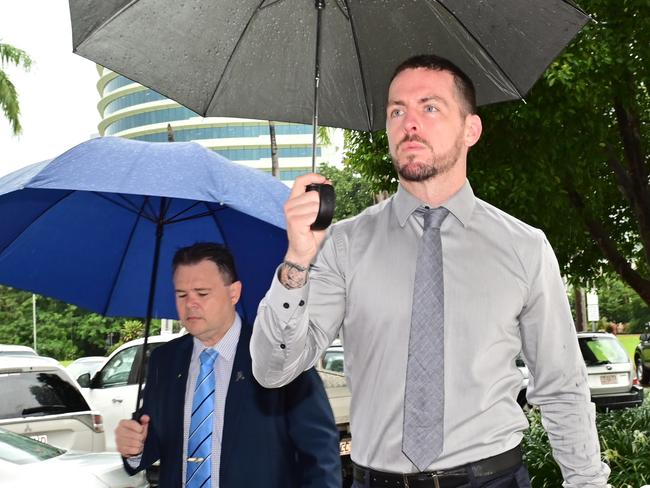
“There was no urgency for them to go into that house at all,” he said.
“They had all the time in the world to discuss a plan, make some decisions about what would happen.”
Sgt Barram also said it was inappropriate for Rolfe to have disengaged a safety mechanism on his Glock pistol holster, as he is allegedly seen doing on body worn camera footage while searching another house in the lead up to the shooting.
“The only time that we’re taught to disengage them is when you’re going to draw the firearm out,” he said.
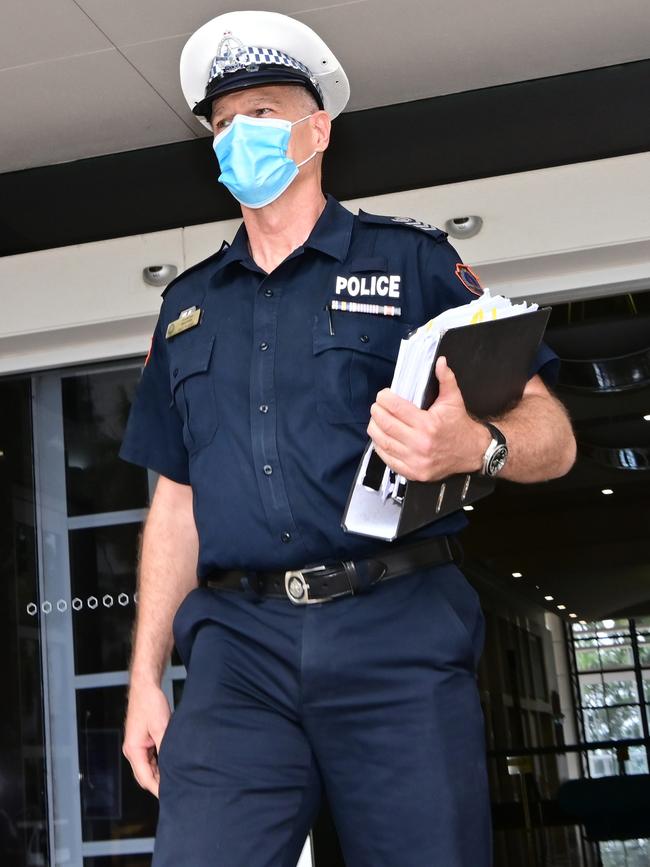
“He’d been told that there was no one there other than a boy that looks about 10 years old and I don’t think it was appropriate that he would have a firearm out.
“Clearly he didn’t either, because he didn’t take it out.”
Crown prosecutor Philip Strickland SC asked Sgt Barram if he thought the search of the first house was “reasonable or necessary in the circumstances”, and Sgt Barram said he did not think it was necessary and “that child should have been evacuated” in any event.
“They were tasked to gather intel about where Mr Walker might spend the night,” he said.
“They’d gained that before they’d gone into the house, from the child and if you’re then going to do a search of the house like that, you would certainly consider getting the child out of the house.”
The trial continues on Tuesday.

Cop’s uniform tested for blood in Zach Rolfe trial
THE section of Adam Eberl’s police shirt near where he may have been stabbed by Kumanjayi Walker in an attempted arrest tested “weakly positive” for blood, a court has heard.
Sgt Eberl’s arrest partner on the day, Zach Rolfe, has pleaded not guilty to all charges after fatally shooting the 19-year-old in Yuendumu in 2019.
On Monday, NT Police forensic science director, Joannah Lee, told the Supreme Court, a “tape lift” from the left shoulder of Sgt Eberl’s shirt produced a “mixed DNA profile”.
But Dr Lee said while the major component of the DNA sample was attributed to Sgt Eberl, there could be several explanations for its presence.

“When we examine a person’s clothing, it’s very common to find their own DNA present on that clothing and that’s generally from the presence of their skin cells,” she said.
“In this instance we have a very weak positive result to blood, so it is not specifically possible to say whether that DNA came specifically from skin cells or whether it could have come from blood that might have been present.”
Dr Lee said she also took a tape lift from the inside of Sgt Eberl’s shirt in the area where he later noticed the injury which tested negative for blood, and a DNA result from that test matching Sgt Eberl was “most likely to come from skin cells”.
“There was no evidence of a bleeding injury present,” she said.
“In the case of a bleeding injury, much like a tissue, if you apply it to an injury you would see that blood is soaked into that area and there was no indication of that.”
The trial continues.





